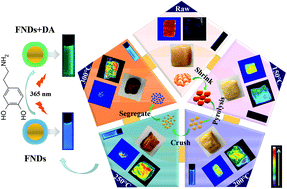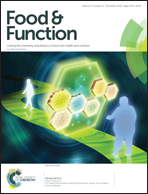Bio-distribution and interaction with dopamine of fluorescent nanodots from roasted chicken†
Abstract
The potential health risks of food-borne nanoparticles are of great concern to public health. In this work, the formation and physicochemical properties of a class of fluorescent nanodots (FNDs) in roasted chicken were investigated. It was found that as the roasting temperature increased from 200 to 300 °C the size of the FNDs decreased significantly, from 17.1 to 2.1 nm. The FNDs, which mainly contain carbon (65%), are strongly fluorescent under ultraviolet light, exhibiting an excitation-dependent emission behavior. The fluorescence quantum yields of the FNDs were determined at 200, 250, and 300 °C, and were found to be 6.71 ± 0.21, 12.85 ± 0.34 and 17.46 ± 0.42%, respectively. These FNDs not only could be taken up by live cells and dispersed within the cytoplasm, but also could pass the blood–brain barrier (BBB) and accumulated in the brains of mice after oral feeding. The results of the fluorescence and Fourier transform infrared (FTIR) spectroscopy analysis clearly indicated that the FNDs can interact with the neurotransmitter dopamine in vitro through the formation of fluorescent conjugates. The relative cell viability decreased by 33% corresponding to FND-300 at a concentration of 4 mg mL−1. These results confirmed the presence of the FNDs in roasted chicken and revealed their potential bioeffects on human health, which calls for more research and evaluation.



 Please wait while we load your content...
Please wait while we load your content...